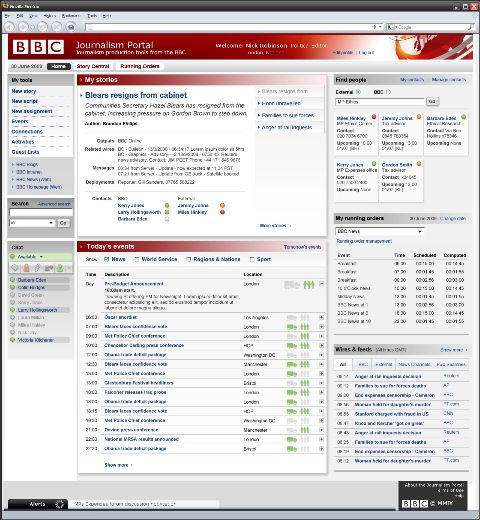The Future of Newsrooms
LONDON—In every broadcast studio around the globe digital technology has revolutionized news from the point of creation, right through to consumption. In the same way that audiences are changing the way they access the news, newsrooms have had to follow suit and change the way they make and break the news.

John Ive
The demand for multimedia and multiplatform has skyrocketed, alongside the popularity of social media networks such as Twitter and Facebook. However, this growth spurt does not extend to broadcasters’ budgets and that is where the challenge lies. The only solution is to work smarter and more efficiently by using the latest technological advancements to future proof the newsroom.
ONE STEP AHEAD
Technology in the newsroom is already making the news production process more and more efficient. Newsrooms around the globe are starting to explore these new technologies both in front of the camera and behind the scenes in a bid to enhance their programming and stay one step ahead of competitors. The pressure on budgets has persuaded broadcasters to turn to innovation, and there are a number of trends emerging as a result.
One key element that is evolving is the newsroom system. Products such as Avid’s iNEWS and AP’s ENPS have led the field for many years and other multiplatform news systems such as Dalet’s News Suite, Ross Video’s Inception News, Octupus’ Octupus 7 or the recently launched Playbox’s NewsRoomBox are now being used to produce content for broadcast news, web, mobile and social media. TV broadcasters are also looking to the growing number of cloud alternatives created specifically for media organizations that have high storage and bandwidth requirements for television and video production.
In the current climate, broadcasters and content distributors have to build platforms that have the flexibility to respond to changing viewer behavior in the most cost-effective way, and the cloud could be the ideal solution. It provides the inherent flexibility, with the ability to rapidly provision new service and infrastructure, and without the large capital outlay. While in the newsroom, it enables employees to edit content on their desktops, laptops, tablets or smartphones instead of in a dedicated edit suite.
Many organizations have traditionally worked in silos with one team responsible for the main program output and a separate one creating content for the Web and other platforms. Newsrooms are increasingly being asked to do more, but with no additional increases in budget allocation, and this means that the costs of having to maintain separate teams for different platforms becomes unsustainable. Putting processes and technology in place that allow greater integration between social media and web platforms—rather than recruiting new staff to manage them separately—is more cost-effective in the long term.
Equally, the ecosystem must be open enough so additional platforms can be supported without having to upgrade the entire infrastructure.
Already on the horizon are a range of private cloud options or public clouds from renowned brands such as Microsoft Azure or Amazon Web Services. In addition, there are a number of broadcasters in the process of developing their own private group clouds to address security concerns. These group clouds have the ability to provide instantaneous private media and data sharing between group stations, and also allow groups to manage assets and metadata more efficiently.
JOURNALISM PORTAL
The increased pressure placed on news broadcasters is already being reflected in the world’s biggest newsrooms and it seems likely that the trend to move away from proprietary newsroom systems and embrace more open environments will continue. Evidence of this can be seen in the BBC, with the corporation creating its own Journalism Portal based on Microsoft Sharepoint, and other cloud-based offerings such as IBM WebSphere offer similar capabilities.

BBC's Journalism Portal
When the BBC first proposed its Journalism Portal in a white paper, it said it aimed to “take the first steps in supporting the growing demands of multiplatform and multimedia production, through the concept of story-based production.” The portal provides a “mashup” point for information and data around which journalists can come together irrespective of their location. It enables users to aggregate information and multimedia content for stories and can also be used for planning purposes.
Advances in technology have seen the role of the journalist change significantly, with more prominence being placed on producing content for multiple screens. Production processes as a whole are becoming more story-led, and new systems, such as the BBC’s, could become the platform where the journalist can plan and author content, as well as aggregate the information and content around any given story. This approach also makes collaboration more efficient, increasing the speed of newsgathering and helping journalists bring greater depth to stories.
The whole area of search and discovery in the newsroom environment is also expected to go through a revolution in years to come. The impact of the Web means that journalists can no longer afford to spend time sifting through reams of information. The systems will become more intelligent and offer the ability to filter content and stories to give journalists swift access to the most relevant and latest information.
In simple terms, the newsroom of the future will incorporate far more automation, in both processes and systems. Journalists will be able to prepare content in a way that can feed out multiple versions automatically without having to craft each by hand. This level of automation will enable broadcasters to achieve multiple outputs without incurring extra costs. Inevitably, there will be fewer staff but they will be working with smarter, more open technology, creating news that can be viewed on the television, the Internet or the latest smart device.
John Ive is the director of business development and technology for the International Association of Broadcast Manufacturers.
Get the TV Tech Newsletter
The professional video industry's #1 source for news, trends and product and tech information. Sign up below.
